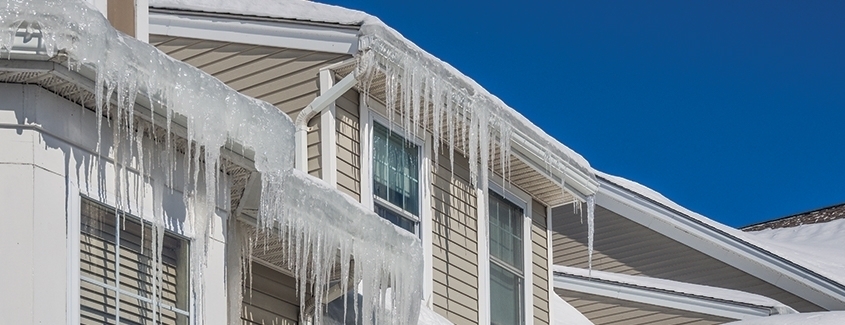If you’ve been listening to the predictions for this Winter here in the Northeast – we’re expecting a rough one! And along with a lot of snow comes those horrid ice dams – a serious problem that will not only do damage to your home, but also is a cause for many winter insurance claims.
If you happen to be new to the North – let me fill you in on what an ice dam is: When snow accumulates on a roof, a cycle of melting and refreezing occurs. In a perfect world, the snow would melt off the roof, enter the gutters, and flow harmlessly to the ground (before it gets too cold – make sure you clean those gutters and follow these other Fall cleaning tips). Or the snow would evaporate from the action of the sun, and never really melt off unless the outside temperature rose above the freezing point. However, two key factors interact to cause problems… the outside temperature and the temperature of the inside of your attic.
The warmer your attic is, the more melt off that occurs at the roof surface. This melted snow would normally flow off the edge of the roof. Under certain conditions, though, when air temperature is very low, the water refreezes at the edge of the roof, where the interior roof surface is not being warmed by the attic. This refreezing gradually forms what is fondly known as an “ice dam”, a growing heap of ice that blocks path of the melted snow.
Once this dam forms to a certain height, the melted snow that pools up behind it can suddenly leak back under the roof shingles and into your home! On a roof with a low slope, it only takes a small ice dam to cause water backup and leakage.I can tell you from personal experience – it’s not a fun situation, especially when water is leaking from the ceiling into your living room!
Now what do you do?
Fix the issue before it’s an issue: Increase the insulation, sealing and ventilation in your attic as soon as possible.
What if you already have an ice dam? Get rid of the ice damn as quickly as possible. A great quick fix is actually an “old farmer’s cures” from This Old House’s website.
- Using a roof rake, remove snow 3-4 feet from the edge of your roof, being careful not to damage the roof covering or to allow snow to build up around walking paths or to block emergency exits.
- Use a calcium chloride ice melt product, which you can generally purchase from your local hardware store. Be sure not to use rock salt or sodium chloride, which can damage your roof.
- Fill a nylon stocking with the calcium chloride ice melt.
- Safely place and position the calcium chloride-filled nylon stocking vertically across the ice dam so that it can melt a channel through the ice.
It’s a great way to reuse and recycle some old hose that may have runs or holes and it’s a heck of a lot easier than getting up on your roof trying to break apart the ice! Have a secret quick fix to dealing with ice dams – we’d love to hear it.
Mary McGrath
mmcgrath@srfm.com
Sinclair Risk & Financial Management


